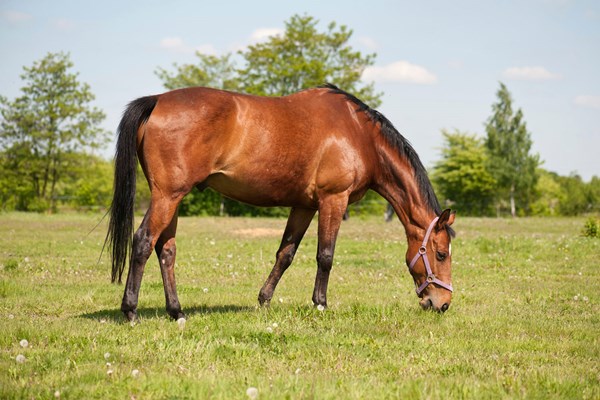 Credit: Thinkstock A horse on good-quality pasture 24 hours a day, seven days a week, will meet his full 2% body weight energy requirement.
Credit: Thinkstock A horse on good-quality pasture 24 hours a day, seven days a week, will meet his full 2% body weight energy requirement.Whether it’s because owners are killing their horses with kindness or if the growing rate of equine obesity is simply mirroring the pandemic in humans, the sad fact is that too many horses are overweight.
“Horses that are overweight have decreased reproductive and athletic performance and are at risk for injuries and metabolic conditions such as insulin resistance and life-threatening sequelae such as laminitis,” said Kathleen Crandell, PhD, a Kentucky Equine Research nutritionist.
What steps can you take to ensure your horse is at an ideal weight?
1. Accurately assess your horse’s body condition score (BCS) and/or body weight.
There are several tools to help do this, such as BCS charts, weight tapes and equine scales. It is important to know what your horse weighs, particularly if you are feeding based on percent of body weight (e.g., 2% of body weight in hay per day). Consistently and correctly determining your horse’s BCS or weight can take some practice!
2. Identify the appropriate BCS for your horse.
Now that you know what your horse’s BCS actually is, it is time to decide what his BCS should be. Most horses should be a 4, 5 or 6 on the Henneke scale, which ranges from 1 to 9. While it may vary depending on your horse’s height and build, Crandell said a general guideline is losing 1 point on the scale is about the equivalent of 50 pounds.
3. Assess your horse’s diet, cutting out unnecessary calories.
Many owners enjoy feeding their horses, giving them treats and using nutritional supplements to ensure all of their horses’ dietary needs are met. Consider all concentrates, supplements, mashes and treats when assessing your horse’s complete diet. Read the labels carefully to minimize both calories and doubling up on certain ingredients (e.g., some joint supplements may also contain vitamins that are included in your horse’s multivitamin supplement). Keep in mind, most horses in less than heavy work can meet all their dietary needs with forage, water and salt.
4. Factor in grazing.
It can be challenging to determine how much pasture is being consumed when your horse is turned out, especially if they are turned out in a group, and depending on the season and quality of the pasture. Crandell says some rules of thumb to go by are:
- A horse on good-quality pasture 24 hours a day, seven days a week, will meet his full 2% body weight energy requirement;
- If a horse is on pasture half of this time, they likely consume only 1% of their body weight in forage, which means supplemental forage is required;
- If the pasture is grazed down approximately 50%, then a horse on pasture full time is likely only receiving 50% of his daily energy requirement. In this situation, an additional 1% of his body weight in forage (or 10 pounds of hay for an average 1,000-pound horse) will be required.
- Horses turned out on a 50% grazed pasture half of their time will, therefore, only be eating one-quarter of their daily energy requirement and will need to be fed three-quarters of their energy requirement in supplemental hay.
5. Avoid “diet drift” after initial success.
Once your horse is at its ideal body weight, be certain to stick with what is working and not slowly start sneaking treats and permitting uncontrolled grazing. Otherwise, the weight could creep back on. Reassess your horse’s body weight periodically to ensure it remains in a healthy range.
6. Consult your veterinarian or an equine nutritionist when necessary.
Recognizing when it is time to help your horse lose weight is a great first step, but this needs to be done safely, especially if you are instituting a new or expanded exercise regime or are considering major diet changes. Not all horses can be put on the same “diet.” For example, horses with insulin resistance or equine metabolic syndrome likely need to be fed differently than a healthy geriatric or a young, overweight horse.
Article courtesy of Kentucky Equine Research. Visit equinews.com/newsletters to subscribe to The Weekly Feed, KER’s award-winning equine nutrition newsletter.


